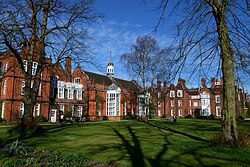Newnham College, Cambridge
| Newnham College
| |||||||||||
 The Newnham College dining hall | |||||||||||
|---|---|---|---|---|---|---|---|---|---|---|---|
 | |||||||||||
| Principal: | Alison Rose | ||||||||||
| Website: | newn.cam.ac.uk | ||||||||||
| |||||||||||
| Location | |||||||||||
| Grid reference: | TL44145779 | ||||||||||
| Location: | 52°11’58"N, -0°6’28"E | ||||||||||
Newnham College is a women's constituent college of the University of Cambridge.
The college was founded in 1871 by a group organising Lectures for Ladies, members of which included philosopher Henry Sidgwick and suffragist campaigner Millicent Garrett Fawcett. It was the second women's college to be founded at Cambridge, following Girton College. The College celebrated its 150th anniversary[1] throughout 2021 and 2022.
History
The history of Newnham begins with the formation of the Association for Promoting the Higher Education of Women in Cambridge in 1869. The progress of women at Cambridge University owes much to the pioneering work undertaken by the philosopher Henry Sidgwick, fellow of Trinity. Lectures for Ladies had been started in Cambridge in 1869,[2] and such was the demand from those who could not travel in and out on a daily basis that in 1871 Sidgwick, one of the organisers of the lectures, rented a house at 74 Regent Street to house five female students who wished to attend lectures but did not live near enough to the University to do so. He persuaded Anne Clough, who had previously run a school in @the Lake District, to take charge of this house. The following year (1872), Clough moved to Merton House (built c. 1800) on Queen's Road,[3] then to premises in Bateman Street. Clough eventually became President of the college.
Demand continued to increase and the supporters of the enterprise formed a limited company to raise funds, lease land and build on it. in 1875 the first building for Newnham College was built on the site off Sidgwick Avenue where the college remains.[4] In 1876 Henry Sidgwick married Eleanor Mildred Balfour who was already a supporter of women's education. They lived at Newnham for two periods during the 1880s and 1890s.[2]
The college formally came into existence in 1880 with the amalgamation of the Association and the Company. Women were allowed to sit University examinations as of right from 1881; their results were recorded in separate class-lists.
The demand from prospective students remained buoyant and the Newnham Hall Company built steadily, providing three more halls, a laboratory and a library, in the years up to the First World War. The architect Basil Champneys was employed throughout this period and designed the buildings in the Queen Anne style to much acclaim, giving the main college buildings an extraordinary unity. These and later buildings are grouped around beautiful gardens, which many visitors to Cambridge never discover, and, unlike most Cambridge colleges, students may walk on the grass for most of the year.
Many young women in mid-19th-century Britain had no access to the kind of formal secondary schooling which would have enabled them to go straight into the same university courses as the young men – the first principal herself had never been a pupil in a school. So Newnham's founders allowed the young women to work at and to a level which suited their attainments and abilities. Some of them, with an extra year's preparation, did indeed go on to degree-level work. And as girls' secondary schools were founded in the last quarter of the 19th century, staffed often by those who had been to the women's colleges of Cambridge, Oxford and London, the situation began to change. In 1890 the Newnham student Philippa Fawcett was ranked above the Senior Wrangler, which is to say top, in the Mathematical Tripos. By the First World War the vast majority of Newnham students were going straight into degree-level courses.
A new Pfeiffer Building was built in 1893, largely funded by £5,000 from a bequest by the poet Emily Jane Pfeiffer to support the education of women.[5] In tailoring the curriculum to the students, Newnham found itself at odds with the other Cambridge college for women, Girton, founded two years earlier. Emily Davies, Girton's founder, believed passionately that equality could only be expressed by women doing the same courses as the men, on the same time-table. This meant that Girton attracted a much smaller intake in its early years. But the Newnham Council held its ground, reinforced by the commitment of many of its members to educational reform generally and a wish to change some of the courses Cambridge was offering to its men.
In 1948 Newnham, like Girton, attained the full status of a college of the university.
Pictures
-
Sidgwick Hall and the sunken garden of Newnham College.
-
A view of Sidgwick.
-
Peile Building.
-
A view of Pfeiffer Arch and the Old Hall building.
-
The Buttery, March 2017
Outside links
| ("Wikimedia Commons" has material about Newnham College, Cambridge) |
References
- ↑ "Newnham150". https://150.newn.cam.ac.uk.
- ↑ 2.0 2.1 Stefan Collini, "Sidgwick, Henry (1838–1900)", Oxford Dictionary of National Biography, Oxford University Press, 2004; online edn, May 2007. Retrieved 4 January 2017
- ↑ St John's College: Queen's Road: Merton House, Cambridge 2000.
- ↑ Template:Cite DNBSupp
- ↑ "Principalship of Mrs Sidgwick" in Alice Gardner, A Short History of Newnham College, Cambridge (2015), p. 85
- Gardner, Alice: 'A Short History of Newnham College, Cambridge' (Bowes & Bowes, 1921)
| Colleges of the University of Cambridge | |
|---|---|
|
Christ’s • Churchill • Clare • Clare Hall • Corpus Christi • Darwin • Downing • Emmanuel • Fitzwilliam • Girton • Gonville and Caius • Homerton • Hughes Hall • Jesus • King’s • Lucy Cavendish • Magdalene • Murray Edwards • Newnham • Pembroke • Peterhouse • Queens’ • Robinson • St Catharine’s • St Edmund’s • St John’s • Selwyn • Sidney Sussex • Trinity • Trinity Hall • Wolfson |
 |





